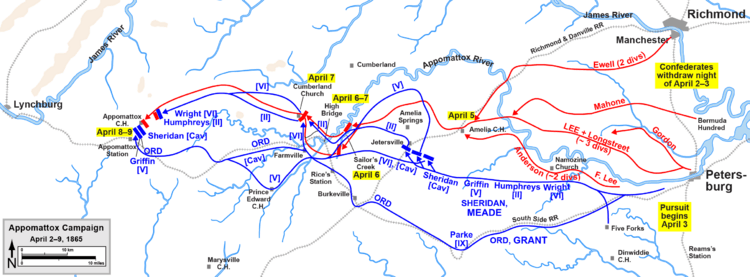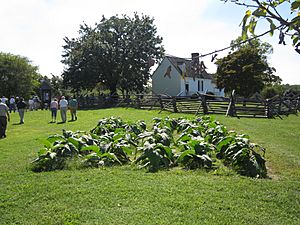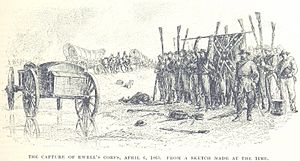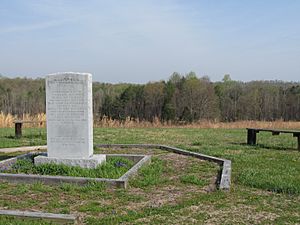Battle of Sailor's Creek facts for kids
Quick facts for kids Battle of Sailor's Creek(Battle of Sayler's Creek) |
|||||||
|---|---|---|---|---|---|---|---|
| Part of the American Civil War | |||||||
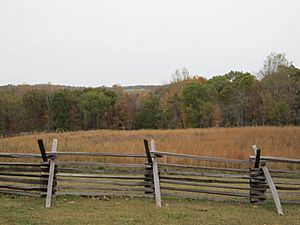 A view of the battlefield as it appeared in 2010 |
|||||||
|
|||||||
| Belligerents | |||||||
| Commanders and leaders | |||||||
| Horatio Wright Philip H. Sheridan |
Richard S. EwellExpression error: Unrecognized punctuation character "{".Expression error: Unrecognized punctuation character "{".Expression error: Unrecognized punctuation character "{". John B. Gordon |
||||||
| Units involved | |||||||
| Army of Northern Virginia | |||||||
| Strength | |||||||
| 25,000–26,000 | 18,500 | ||||||
| Casualties and losses | |||||||
| 1,148 | 7,700 captured; killed/wounded unknown | ||||||
The Battle of Sailor's Creek happened on April 6, 1865, in Virginia. It was a major fight near the end of the American Civil War. This battle was part of the Appomattox Campaign.
It was one of the last big battles between the Confederate Army of Northern Virginia, led by General Robert E. Lee, and the Union Army, led by Lieutenant General Ulysses S. Grant.
After leaving Petersburg, the tired and hungry Confederate soldiers marched west. They hoped to get supplies and join another Confederate army in North Carolina. But the stronger Union army kept up with them. The land was rough, with creeks and high hills, making it hard for the Confederates' long wagon trains to move.
Two small bridges over Sailor's Creek and Little Sailor's Creek caused a huge traffic jam. This made it even harder for the Confederates to escape. After some intense hand-to-hand fighting, about a quarter of the remaining Confederate soldiers were lost. This included several generals who were captured.
General Lee watched the surrender from a nearby hill. He famously asked, "My God, has the army dissolved?" A general named William Mahone replied, "No, General, here are troops ready to do their duty."
The battle is sometimes called Sayler's Creek, using an older spelling.
Contents
Background
The War Situation
Before the Battle of Sailor's Creek, the Confederate army was in a tough spot. Union General Grant's army had broken through the Confederate defenses at Petersburg, Virginia. This happened at the Battle of Five Forks on April 1 and the Third Battle of Petersburg on April 2.
A Union division also cut off the last railroad line on April 2. This meant the Confederates couldn't get supplies or retreat by train. General Lee's army left Petersburg and the Confederate capital of Richmond on the night of April 2–3. They hoped to meet up with another Confederate army in North Carolina.
Chasing the Confederates
Most of Lee's army marched west on roads north of the Appomattox River. On April 3, Union cavalry chased the Confederate rear guard. There were small fights at Namozine Creek, Namozine Church, and Sweathouse Creek.
Union cavalry captured Brigadier General Rufus Barringer and many of his men. The Union lost 95 soldiers killed and wounded that day. The Confederates had 15 wounded and 350 captured.
March to Amelia Court House
Most of the Confederate army marched about 21 miles (34 km) west on April 3. They were trying to reach Amelia Court House, which General Lee had set as a meeting point.
Many soldiers had to cross the Appomattox River. They used a single muddy road or took long detours because of floods and broken bridges. This slowed them down a lot.
By the evening of April 3, some troops had crossed the river. But others were still trying to cross or were waiting for others to catch up. One bridge they expected was not there, causing more delays.
Skirmishes at Beaver Pond Creek
On April 4, Union cavalry divisions rode west. They found Confederate soldiers building defenses to protect the retreating army.
Union cavalry skirmished with Confederate infantry. They fought late in the day, but the Union forces were ordered to pull back.
Problems at Amelia Court House
On April 4, Union cavalry reached important railroad crossings. This blocked the Confederate escape route to the southwest. More Union infantry arrived and started digging trenches. This meant Lee could no longer move south along the railroad.
Lee had hoped to find food for his army at Amelia Court House. But he found only a small amount of food and a train full of weapons. He waited for the rest of his army to arrive and sent out groups to find food. But they found very little.
Lee also ordered that the army reduce its wagons and cannons. He wanted to send the extra equipment away or destroy it. This would make the army lighter and faster.
Lee later said that the delay at Amelia Court House led to the Confederate defeat. Some historians believe the missing pontoon bridge was a key reason for the delay.
Cavalry Raids at Paineville
On April 5, Union cavalry went to scout for Confederate movements. Near Paineville, they found a Confederate wagon train. This train was carrying food and ammunition for Lee's army.
The Union cavalry attacked the wagon train. They captured soldiers and teamsters, destroyed many wagons, and burned supplies. They also captured some of Lee's own headquarters wagons.
Confederate cavalry then attacked the Union forces. There was a fight near Amelia Springs. Union reinforcements arrived, allowing the Union cavalry to return with their prisoners and captured items.
The Union cavalry had 13 killed, 81 wounded, and 72 missing. They captured 320 Confederate soldiers and destroyed about 200 wagons.
Blocked at Jetersville
On April 5, Lee's army started marching toward Jetersville. Lee soon found that his escape route along the railroad was blocked by Union cavalry. Union infantry was also nearby.
Lee decided his men were too spread out and it was too late to attack the Union forces. So, the Confederates had to change their plan. They would march to Farmville, where Lee hoped to find 80,000 rations.
The Confederate march was delayed again because a bridge was out at Flat Creek. It needed repairs for wagons and cannons to pass.
Union Plan
Union General Grant and General Sheridan met late on April 5. They believed Lee was moving west to escape. Grant ordered his troops to be ready to move at daybreak.
The Union II, V, and VI Corps were ready to move against the Confederate army.
Opposing forces
Union
Confederate
Initial movements
March and Pursuit
The Confederate army's march west from Amelia Springs put them in a dangerous spot. Their long lines of soldiers and wagons became spread out. They were also delayed at bridges over Sailor's Creek and Little Sailor's Creek. There were also steep hills to cross.
Lee's army marched through the night of April 5–6. The leading corps reached Rice's Station by sunrise. General Lee joined them there. They planned to wait for the rest of the army.
The Confederate corps moved on parallel roads. But after Deatonville, everyone had to use a single road to get to Rice's Station. This made them very vulnerable to attack.
The wagon trains were on the right side of the army, heading for a crossing at Perkinson's mill. The troops planned to cross the river about 2 miles (3.2 km) higher up.
The road to Rice's Station became a marshy area near Sandy Creek. Sailor's Creek was further down the road, with a steep hill on the other side. The land was full of woods, swamps, and open fields.
General Sheridan sent his cavalry to follow a road parallel to Lee's march. He wanted to cut off the Confederates. The cavalry moved west, with one division leading the way.
Battle
The Battle of Sailor's Creek was actually three main fights happening at the same time, very close to each other.
- General Horatio Wright's VI Corps fought General Richard S. Ewell's corps at the Hillsman House.
- Union cavalry led by General Wesley Merritt fought General Richard Anderson's corps at Marshall's Crossroads.
- General Andrew A. Humphreys's II Corps fought General John B. Gordon's corps at Lockett's Farm.
Humphreys vs. Gordon: Battle of Lockett's Farm
On the rainy morning of April 6, Union II Corps first moved toward the Confederate wagon train. But they soon saw Lee's army moving west. The Union troops quickly changed direction and chased them.
A running battle started around 9:00 a.m. between the Union II Corps and Gordon's smaller Confederate corps. Confederate cavalry helped Gordon's infantry.
Gordon's march was stopped by the slow-moving wagon train at Deatonville. This forced his corps to make a stand. Union cavalry tried to help the II Corps, but Gordon's men drove them off.
Union troops charged Gordon's position, taking many casualties. But they captured flags and hundreds of prisoners. They also found many weapons and ammunition left behind by the Confederates.
After General Ewell sent the wagon trains north, Gordon's corps followed them, covering the wagons. The Union II Corps kept chasing them closely. The fighting continued for about 3 miles (4.8 km).
The bridges over Little Sailor's Creek and Big Sailor's Creek were broken. This trapped hundreds of wagons and blocked Gordon's path. The Union II Corps quickly closed in. Gordon's corps fell back after some resistance. The fighting stopped at dark, and many of Gordon's men escaped. Gordon reported that his disorganized men marched all night, and "many threw their guns away."
The Union II Corps captured 13 flags, 4 cannons, and 1,700 prisoners.
Crook, Merritt vs. Anderson: Battle of Marshall's Crossroads
Union General George Crook's cavalry division started attacking the Confederate wagon train and supporting infantry. Crook's lead brigade attacked General Anderson's men, scattering them. The cavalry burned about two dozen wagons. Anderson reorganized his troops and pushed back the Union attackers.
A gap opened in the Confederate line of march because Crook's cavalry had delayed Anderson's corps. Anderson crossed Little Sailor's Creek and reached Marshall's Crossroad. There, he found Union cavalry blocking his way.
Union General George Armstrong Custer's division saw the gap between Confederate forces. His men charged the Confederate artillery, capturing ten cannons. Other Union cavalry arrived to harass Anderson's line. Anderson's men counterattacked but then stopped.
The Union cavalry charged Anderson's infantry several times. Finally, a strong charge by Union brigades caused the entire Confederate line to collapse. The remaining soldiers fled.
Wright vs. Ewell: Battle of Hillsman's House
Confederate cavalry told General Ewell that Union cavalry was blocking the road ahead. Ewell sent the trailing wagon train north to avoid the Union forces. Ewell's corps then closed the gap with Anderson's corps and helped push back a Union attack.
After Anderson crossed Little Sailor's Creek, Ewell moved his troops to higher ground. He left some men as a rear guard at the Hillsman farm. Ewell and Anderson met to discuss their next move. But before they could finish, General Wright's VI Corps appeared behind Ewell. This forced Anderson's corps to face Union cavalry, while Ewell's corps had to fight Union infantry. The two Confederate corps fought almost back-to-back against the surrounding Union forces.
The VI Corps attacked Ewell's line around 6:00 p.m. after an artillery bombardment. Many Union soldiers were shot while crossing Sailor's Creek, which was like a wide swamp in some places. The Union troops reorganized and continued their attack.
The middle of the Union line was pushed back by heavy fire and a Confederate counterattack. However, because the Confederate line was shorter, their attack led them into a trap. Union artillery played a key role in pushing them back. There was fierce hand-to-hand combat. Finally, the Confederates realized they were surrounded and surrendered.
General Humphreys wrote that almost all of Ewell's command was killed, wounded, or captured.
Casualties
The Union army had about 1,180 soldiers killed and wounded.
The Confederate army lost at least 8,000 soldiers killed, wounded, or captured. Most of their wagon trains were destroyed. About one-fifth of the remaining Confederate army was lost in this battle. Many Confederate officers were captured, including several generals.
The disorder after earlier defeats and the lack of food and sleep caused many Confederate soldiers to fall out of line or wander off in search of food.
Aftermath
When General Lee heard about the defeat at Sailor's Creek, he returned to a hill overlooking the battlefield. He saw the survivors streaming along the road.
Lee famously asked, "My God, has the army dissolved?" General Mahone replied, "No, General, here are troops ready to do their duty." Lee was touched and told Mahone, "Yes, there are still some true men left."
Mahone's division stayed on the opposite bank, protecting the escaping soldiers. They did not fight any more.
Captain Thomas Custer, brother of General George Armstrong Custer, received his second Medal of Honor in four days for his actions in this battle.
General Philip Sheridan said that this battle was very important, but it was overshadowed by Lee’s surrender just three days later.
Naming the Battle
The official name for the creek today is Sayler's Creek. However, during the Civil War, maps often used the spelling Sailors. Because of this, many historians and organizations use the spelling "Sailor's Creek" for the battle. The battle is also known by other names like Harper's Farm or Lockett's Farm.
Battlefield Preservation
The Sayler's Creek Battlefield was named a National Historic Landmark in 1985. Part of the battlefield is now Sailor's Creek Battlefield Historical State Park. Groups like the American Battlefield Trust have helped buy and protect over 1,300 acres (5.3 km2) of the battlefield.
See also
 In Spanish: Batalla de Sailor's Creek para niños
In Spanish: Batalla de Sailor's Creek para niños


